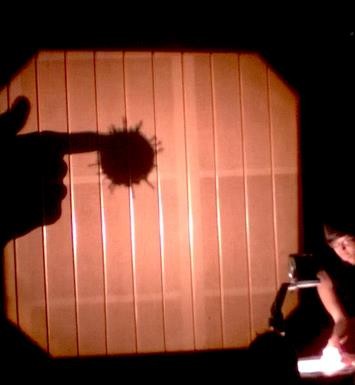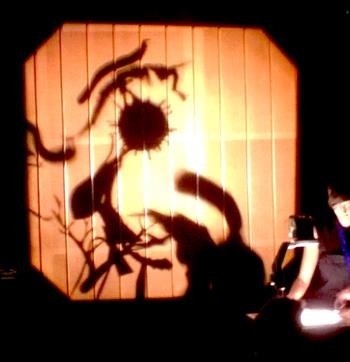- Kayla Anderson
- Sria Chatterjee
- Rohini Devasher
- Eiko Honda
- Maya Kóvskaya
- Jia-Hui Lee
- Angela Rawlings
- Pinar Yoldas
Shadow Speculakon
The Speculakon, as a device with which to speculate, came out of the word “speculative” that had been given to us. The idea of using shadows to create a being or world—or, in other words, to speculate—draws on the “specular” in “speculative.” Specular reflection is the mirror-like reflection of light (or of other kinds of wave) from a surface, in which light from a single incoming direction (a ray) is reflected into a single outgoing or ingoing direction.
Framing Statement
Our Speculakon does exactly this. Fusing shadow puppetry, an overhead projector, and paper cutouts of random appendages taken from machines, microbes, plants, and animals, our group wanted to pose the question: What life-forms can we speculate in the Anthropocene? Invoking an indeterminate time when the world appears only as glimmering shadows, the Speculakon invites participants to re-enter Plato’s Cave to speculate on the forms, thoughts, and movement of anthropocenic life.
Participants are divided into being-builders and world-builders. The being-builder puts together tentacles, robotic arms, spinal cords, flowers, T-cells, and other mechanical and bodily parts, on a screen, to create anthropocenic life forms that float over the humming soundscapes of drones and working ants. World-builders utter phrases in bits and bytes that offer clues to the life-forms and worlds before us. “My name is Rocky Fizzmer. Am I a microcyborg? What time is it? In this fluid atmosphere, I cannot tell if I am fizzing or swimming.”
Through the Speculakon, we hoped to speculate ways of sensing, types of consciousness, and life-forms that emerge in an Anthropocene age. The result is a magnetic, time-altering experience in penumbral light; a meditative, sometimes humorous speculation on life-forms in the Anthropocene.
Below, we present several images and components of the Speculakon.
Directions
With the Speculakon, we want to take you into an indeterminate time,
where sunlight has dimmed into an eclipsal penumbral.
We can only see in shadows and forms.
You are in a world and time that is not your own.
Your body has changed.
These are your shadows and this is what you are hearing.
Every group has one being-builder and the rest of you are world-builders. The being-builder builds a being at the projector from the pieces provided. The world-builders contribute one sentence each to create a world for the being.
Attention! World-builders, drawing from the glossary on the wall, tell us about who or what you are, your temporality, your environment, and how you sense it.
Outside participant reflection
By Angela Rawlings
In a shadow world, where I wake up as an entity unaware of my own body form, inclination, or identity, how do I cultivate awareness of my corporeality through impulses that arise when I encounter soundscape and shadows?
I listen. I am aware that I have the capacity to listen. I name this action: to listen. Repetition, rhythm. Pulse. Familiarity. I’ve awoken in a place I knew, should know, will know. I’ve awoken!
And I see dim shapes. I see! How do the shapes relate to me? What action manifests when I sense an other? This oblong shape crowned with spines moves in staccato arcs. Slow, slower. Impulsively, I desire. Action: connect. I don’t yet know what orifices my body may contain, but I desire “in.” This other: connect, in.
I utter. I realize I have voice, and I think thoughts into sound. Describe my urges aloud, and my desire, through possessive familiar-foreign neologism. “My honeyfur, my honeyfur.”
Lyricism undoes me.
This speculative aesthetic experiment brought me full-bodied into a state of unknowing, unlearning, and I met my own assumptions and voice with so much necessary questioning that any utterance became just what the experiment requested: speculation. Necessary wobble estranging what was once familiar, known.
I refract later this sense of awe and unknowing when, again, I read Louise Glück’s “Trillium,” perhaps useful as a text to accompany this powerful experiment.1



